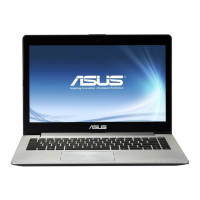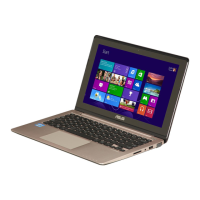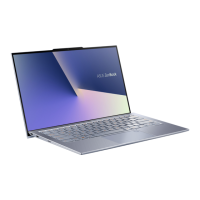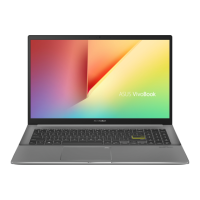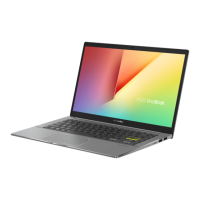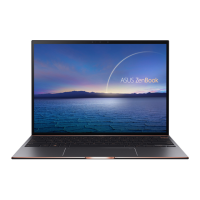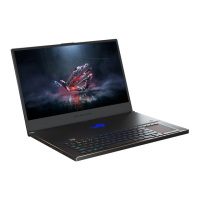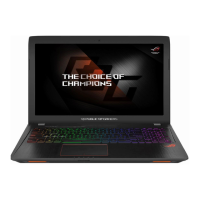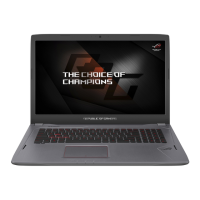Do you have a question about the Asus S400CA and is the answer not in the manual?
Illustrates icons indicating devices used for tasks and procedures.
Explains text formatting conventions like bold and italic for menu items and references.
Covers safety measures during the operation of the Notebook PC.
Introduces the Notebook PC and its various components.
Illustrates and describes components on the top: microphone, camera, display, power button, numeric keypad.
Illustrates and describes bottom components: battery indicators, drive activity, wireless, capital lock, speakers, vents.
Details ports and features on the right side: USB 3.0, HDMI, VGA, LAN, Power input.
Details ports and features on the left side: Kensington lock, USB 2.0, audio/mic jack, memory card reader.
Guides initial setup: charging, opening display, pressing power button.
Explains touch screen gestures: edge swipes, zoom, tap/hold, tap/double tap.
Details touchpad operations: pointer movement, one-finger gestures, two-finger gestures, three-finger gestures.
Explains keyboard functions: Fn keys, ASUS app keys, Windows keys, multimedia controls.
Guides initial setup: language, license terms, basic items configuration, tutorial.
Describes the Windows® 8 lock screen and how to proceed to the OS.
Explains the Windows® 8 tile-based UI, Start screen, and apps.
Describes onscreen hotspots for launching programs and accessing settings on the Start screen and apps.
Covers launching, customizing (moving, resizing, unpinning), and closing applications in Windows® 8.
Explains how to access and launch applications via the Apps screen.
Details how to add more apps to the Start screen using touch or touchpad.
Describes the Charm bar's function and how to launch it for sharing and settings access.
Explains the functions of Search, Share, Devices, and Settings within the Charm bar.
Explains how to display two apps side-by-side for multitasking.
Lists keyboard shortcuts for launching apps, navigating the OS, and accessing system functions.
Guides users on connecting to Wi-Fi and Bluetooth networks, and managing Airplane mode.
Explains how to pair and connect with Bluetooth-enabled devices.
Describes how to turn Airplane mode on and off for wireless communication.
Guides users on connecting to wired networks via the LAN port.
Provides steps for setting up dynamic IP or PPPoE network connections.
Provides steps for setting up a static IP network connection.
Explains how to properly shut down or turn off the Notebook PC.
Describes how to put the Notebook PC into sleep mode.
Introduces and describes key ASUS applications.
Details the LifeFrame app for webcam functions like snapshots, video recording, and monitoring.
Explains how to optimize performance and battery life using Power4Gear modes.
Describes how to save battery power using deep sleep mode (Deep S3) with Instant On.
Explains POST process for diagnostics, and how to access BIOS/troubleshooting.
Describes the BIOS system and its essential hardware settings for startup.
Provides instructions on how to access the BIOS during POST.
Details various BIOS settings, including boot options.
Explains how to set boot option priorities in the BIOS.
Covers security settings: passwords (admin, user, HDD), I/O interface security (LAN, USB), secure boot.
Explains how to lock or unlock interface functions like LAN and USB in BIOS.
Details how to lock or unlock USB ports and devices through the BIOS.
Describes how to set a master password for hard disk drive access in the BIOS.
Explains saving settings and exiting BIOS, and provides instructions for updating the BIOS.
Provides instructions for downloading and updating the Notebook PC's BIOS.
Guides users through troubleshooting options available via POST, including refresh, reset, and advanced options.
Explains how to refresh the PC without losing files and applications.
Details how to reset the Notebook PC to its default settings.
Covers advanced troubleshooting options.
Explains how to recover the system using an original image file.
Provides information about the DVD-ROM drive and regional playback restrictions.
Lists countries associated with different DVD playback regions.
Provides information about the Blu-ray ROM drive and region definitions.
Details the compliance of the internal modem with various international standards and CTR 21.
States network compatibility, manufacturer's declaration, and non-voice equipment eligibility.
Explains eligibility criteria for non-voice equipment like modems and fax machines.
Outlines FCC compliance rules for device operation, interference, and RF exposure.
Warns about RF exposure and compliance requirements for the device.
Lists completed items relevant to R&TTE directive essential requirements and testing.
Indicates CE marking compliance for devices with and without wireless functions.
Outlines IC radiation exposure limits and operation conditions for Canada.
Specifies wireless channels used in different geographical domains.
Details restricted wireless frequency bands and power limits in France.
Provides safety precautions related to UL standards for telecommunications equipment and batteries.
Specifies requirements for power cords based on current ratings and weight.
Provides installation notes for CATV system installers.
References ASUS REACH website for chemical substance information.
Warns about dangers of improper lithium-ion battery replacement and disposal.
Provides safety warnings related to optical drives, laser products, and service labels.
Highlights warnings regarding invisible laser radiation when the optical drive is open.
Details FDA regulations for laser products manufactured in the US.
Informs about copyright protection technology and usage restrictions.
Presents CTR 21 approval details in multiple languages for modem compliance.
Describes ENERGY STAR compliance and power management features for energy efficiency.
Explains the characteristics of the EU Flower label awarded to the Notebook PC for environmental friendliness.
Advises users to avoid listening at high volume levels for extended periods to prevent hearing damage.
Details ASUS's commitment to global environmental regulations and compliance.
Provides information on ASUS's recycling and takeback programs for responsible product disposal.
Explains the application of coating for electrical insulation and safety on the device.
Illustrates icons indicating devices used for tasks and procedures.
Explains text formatting conventions like bold and italic for menu items and references.
Covers safety measures during the operation of the Notebook PC.
Introduces the Notebook PC and its various components.
Illustrates and describes components on the top: microphone, camera, display, power button, numeric keypad.
Illustrates and describes bottom components: battery indicators, drive activity, wireless, capital lock, speakers, vents.
Details ports and features on the right side: USB 3.0, HDMI, VGA, LAN, Power input.
Details ports and features on the left side: Kensington lock, USB 2.0, audio/mic jack, memory card reader.
Guides initial setup: charging, opening display, pressing power button.
Explains touch screen gestures: edge swipes, zoom, tap/hold, tap/double tap.
Details touchpad operations: pointer movement, one-finger gestures, two-finger gestures, three-finger gestures.
Explains keyboard functions: Fn keys, ASUS app keys, Windows keys, multimedia controls.
Guides initial setup: language, license terms, basic items configuration, tutorial.
Describes the Windows® 8 lock screen and how to proceed to the OS.
Explains the Windows® 8 tile-based UI, Start screen, and apps.
Describes onscreen hotspots for launching programs and accessing settings on the Start screen and apps.
Covers launching, customizing (moving, resizing, unpinning), and closing applications in Windows® 8.
Explains how to access and launch applications via the Apps screen.
Details how to add more apps to the Start screen using touch or touchpad.
Describes the Charm bar's function and how to launch it for sharing and settings access.
Explains the functions of Search, Share, Devices, and Settings within the Charm bar.
Explains how to display two apps side-by-side for multitasking.
Lists keyboard shortcuts for launching apps, navigating the OS, and accessing system functions.
Guides users on connecting to Wi-Fi and Bluetooth networks, and managing Airplane mode.
Explains how to pair and connect with Bluetooth-enabled devices.
Describes how to turn Airplane mode on and off for wireless communication.
Guides users on connecting to wired networks via the LAN port.
Provides steps for setting up dynamic IP or PPPoE network connections.
Provides steps for setting up a static IP network connection.
Explains how to properly shut down or turn off the Notebook PC.
Describes how to put the Notebook PC into sleep mode.
Introduces and describes key ASUS applications.
Details the LifeFrame app for webcam functions like snapshots, video recording, and monitoring.
Explains how to optimize performance and battery life using Power4Gear modes.
Describes how to save battery power using deep sleep mode (Deep S3) with Instant On.
Explains POST process for diagnostics, and how to access BIOS/troubleshooting.
Describes the BIOS system and its essential hardware settings for startup.
Provides instructions on how to access the BIOS during POST.
Details various BIOS settings, including boot options.
Explains how to set boot option priorities in the BIOS.
Covers security settings: passwords (admin, user, HDD), I/O interface security (LAN, USB), secure boot.
Explains how to lock or unlock interface functions like LAN and USB in BIOS.
Details how to lock or unlock USB ports and devices through the BIOS.
Describes how to set a master password for hard disk drive access in the BIOS.
Explains saving settings and exiting BIOS, and provides instructions for updating the BIOS.
Provides instructions for downloading and updating the Notebook PC's BIOS.
Guides users through troubleshooting options available via POST, including refresh, reset, and advanced options.
Explains how to refresh the PC without losing files and applications.
Details how to reset the Notebook PC to its default settings.
Covers advanced troubleshooting options.
Explains how to recover the system using an original image file.
Provides information about the DVD-ROM drive and regional playback restrictions.
Lists countries associated with different DVD playback regions.
Provides information about the Blu-ray ROM drive and region definitions.
Details the compliance of the internal modem with various international standards and CTR 21.
States network compatibility, manufacturer's declaration, and non-voice equipment eligibility.
Explains eligibility criteria for non-voice equipment like modems and fax machines.
Outlines FCC compliance rules for device operation, interference, and RF exposure.
Warns about RF exposure and compliance requirements for the device.
Lists completed items relevant to R&TTE directive essential requirements and testing.
Indicates CE marking compliance for devices with and without wireless functions.
Outlines IC radiation exposure limits and operation conditions for Canada.
Specifies wireless channels used in different geographical domains.
Details restricted wireless frequency bands and power limits in France.
Provides safety precautions related to UL standards for telecommunications equipment and batteries.
Specifies requirements for power cords based on current ratings and weight.
Provides installation notes for CATV system installers.
References ASUS REACH website for chemical substance information.
Warns about dangers of improper lithium-ion battery replacement and disposal.
Provides safety warnings related to optical drives, laser products, and service labels.
Highlights warnings regarding invisible laser radiation when the optical drive is open.
Details FDA regulations for laser products manufactured in the US.
Informs about copyright protection technology and usage restrictions.
Presents CTR 21 approval details in multiple languages for modem compliance.
Describes ENERGY STAR compliance and power management features for energy efficiency.
Explains the characteristics of the EU Flower label awarded to the Notebook PC for environmental friendliness.
Advises users to avoid listening at high volume levels for extended periods to prevent hearing damage.
Details ASUS's commitment to global environmental regulations and compliance.
Provides information on ASUS's recycling and takeback programs for responsible product disposal.
Explains the application of coating for electrical insulation and safety on the device.
| RAM | 4GB DDR3 |
|---|---|
| Storage | 500GB HDD |
| Graphics | Intel HD Graphics 4000 |
| Operating System | Windows 8 |
| Weight | 1.8 kg |
| Processor | Intel Core i3-3217U |
| Display | 14-inch HD (1366x768) |
| Battery | 3-cell |
| Dimensions | 339 x 239 x 21 mm |
